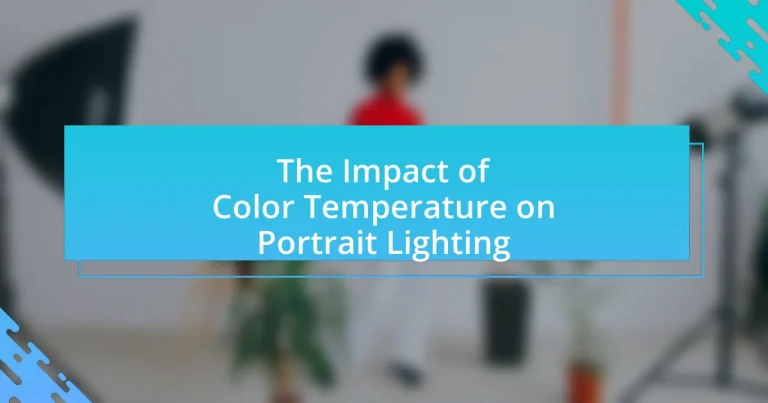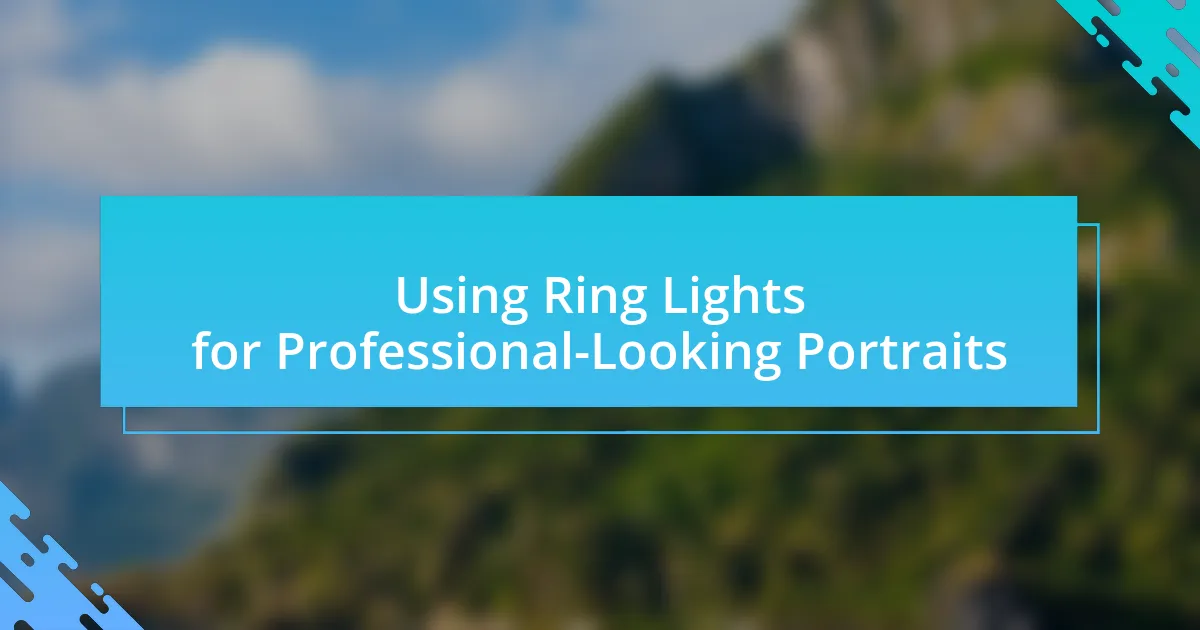The article examines the impact of color temperature on portrait lighting, highlighting its crucial role in shaping the mood and emotional perception of images. It discusses the effects of warmer color temperatures (2700K to 3500K) in creating inviting atmospheres that enhance skin tones, while cooler temperatures (5000K to 6500K) can evoke a more clinical or dramatic feel. The article also outlines the different color temperature ranges used in portrait lighting, their influence on skin tones, and the importance of understanding color temperature for photographers to achieve desired aesthetics and emotional responses in their work. Additionally, it addresses practical applications, tools for controlling color temperature, common mistakes, and resources for further learning.
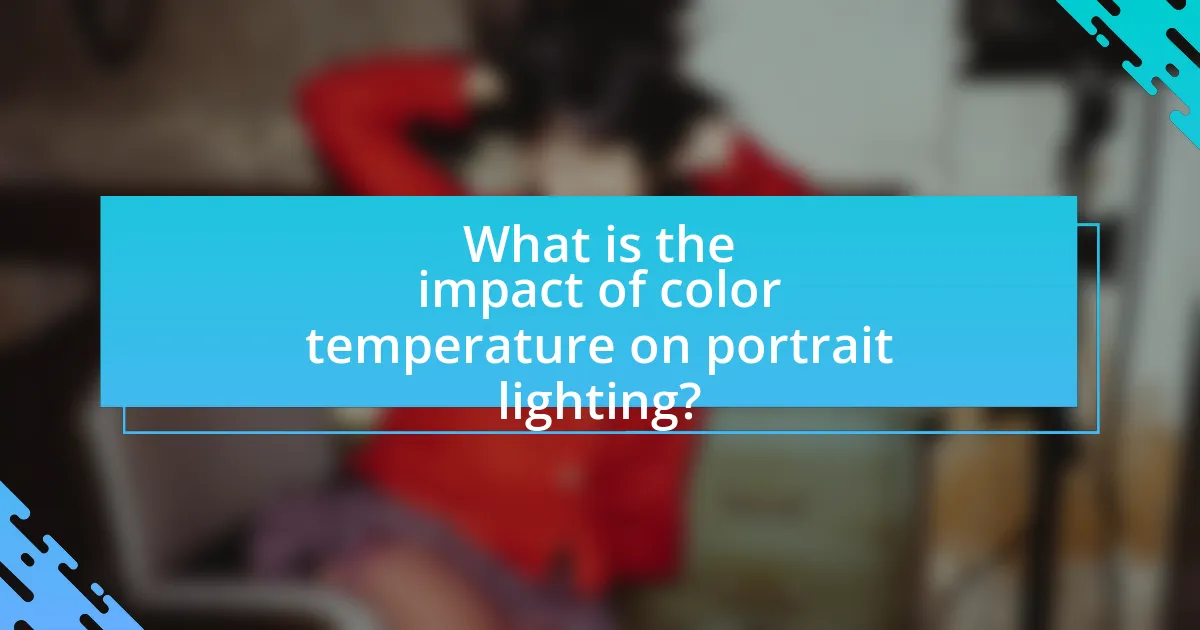
What is the impact of color temperature on portrait lighting?
Color temperature significantly influences portrait lighting by affecting the mood and tone of the image. Warmer color temperatures, typically around 2700K to 3500K, create a soft, inviting atmosphere that enhances skin tones, making subjects appear more vibrant and approachable. Conversely, cooler color temperatures, ranging from 5000K to 6500K, produce a more clinical or dramatic effect, which can emphasize shadows and textures, potentially making the subject appear more serious or stark. Research indicates that color temperature can alter emotional perception; for instance, a study published in the Journal of Experimental Psychology found that warmer lighting is often associated with feelings of comfort and relaxation, while cooler lighting can evoke alertness and focus. Thus, understanding color temperature is crucial for photographers aiming to convey specific emotions and aesthetics in portraiture.
How does color temperature influence the mood of a portrait?
Color temperature significantly influences the mood of a portrait by affecting the emotional perception of the image. Warmer color temperatures, typically ranging from 3000K to 4000K, evoke feelings of comfort, intimacy, and warmth, often associated with sunrise or sunset lighting. In contrast, cooler color temperatures, generally above 5000K, can create a sense of calmness, detachment, or even sadness, reminiscent of overcast skies or shadowy environments. Research indicates that color temperature can alter viewer emotions; for instance, a study published in the Journal of Experimental Psychology found that warmer hues are linked to positive emotional responses, while cooler hues tend to elicit more neutral or negative feelings. Thus, the choice of color temperature is crucial for photographers aiming to convey specific moods in portraiture.
What are the different color temperature ranges used in portrait lighting?
The different color temperature ranges used in portrait lighting typically fall between 3200K and 5600K. Specifically, tungsten lighting is around 3200K, which produces a warm, yellowish tone, while daylight-balanced lighting is approximately 5600K, offering a cooler, bluish hue. These ranges are crucial for achieving desired skin tones and overall mood in portrait photography, as they directly influence how colors are rendered in the final image.
How does the choice of color temperature affect skin tones in portraits?
The choice of color temperature significantly affects skin tones in portraits by altering the perceived warmth or coolness of the skin. Warmer color temperatures, typically around 3200K to 4500K, enhance the natural warmth of skin tones, making them appear more vibrant and healthy. In contrast, cooler color temperatures, such as those above 5500K, can create a more subdued or even unnatural appearance, often leading to skin tones that look pale or washed out. This effect is supported by the principles of color theory, where warmer light enhances reds and yellows in skin tones, while cooler light emphasizes blues and greens, potentially diminishing the overall aesthetic quality of the portrait.
Why is understanding color temperature important for photographers?
Understanding color temperature is crucial for photographers because it directly influences the mood, tone, and overall quality of an image. Photographers must recognize that different light sources emit varying color temperatures, measured in Kelvin, which can affect how colors appear in photographs. For instance, daylight typically has a color temperature around 5500K, while tungsten light is around 3200K, creating warmer tones. By mastering color temperature, photographers can make informed decisions about lighting setups, achieve accurate color representation, and enhance the emotional impact of their portraits. This knowledge allows for better control over the final image, ensuring that the intended aesthetic is achieved.
How can color temperature enhance or detract from a portrait’s composition?
Color temperature can significantly enhance or detract from a portrait’s composition by influencing the mood and emotional response of the viewer. Warm color temperatures, typically ranging from 3000K to 5000K, create a sense of intimacy and warmth, making subjects appear more inviting and approachable. Conversely, cool color temperatures, often above 5000K, can evoke feelings of detachment or sadness, which may not align with the intended emotional tone of the portrait.
For instance, a study by the University of California, Berkeley, found that warm lighting conditions led to higher perceived warmth and friendliness in portraits, while cooler lighting was associated with feelings of distance and aloofness. This demonstrates that the choice of color temperature directly impacts the viewer’s interpretation of the subject’s character and the overall effectiveness of the composition.
What role does color temperature play in post-processing portraits?
Color temperature significantly influences the mood and aesthetic of portraits during post-processing. Adjusting color temperature can enhance skin tones, create warmth or coolness, and evoke specific emotional responses. For instance, warmer color temperatures (around 3000K to 4000K) can impart a cozy, inviting feel, while cooler temperatures (above 5000K) can convey a more clinical or detached atmosphere. Studies in photography emphasize that the correct color temperature can improve the overall quality of the image, making skin tones appear more natural and appealing, thus enhancing viewer engagement.
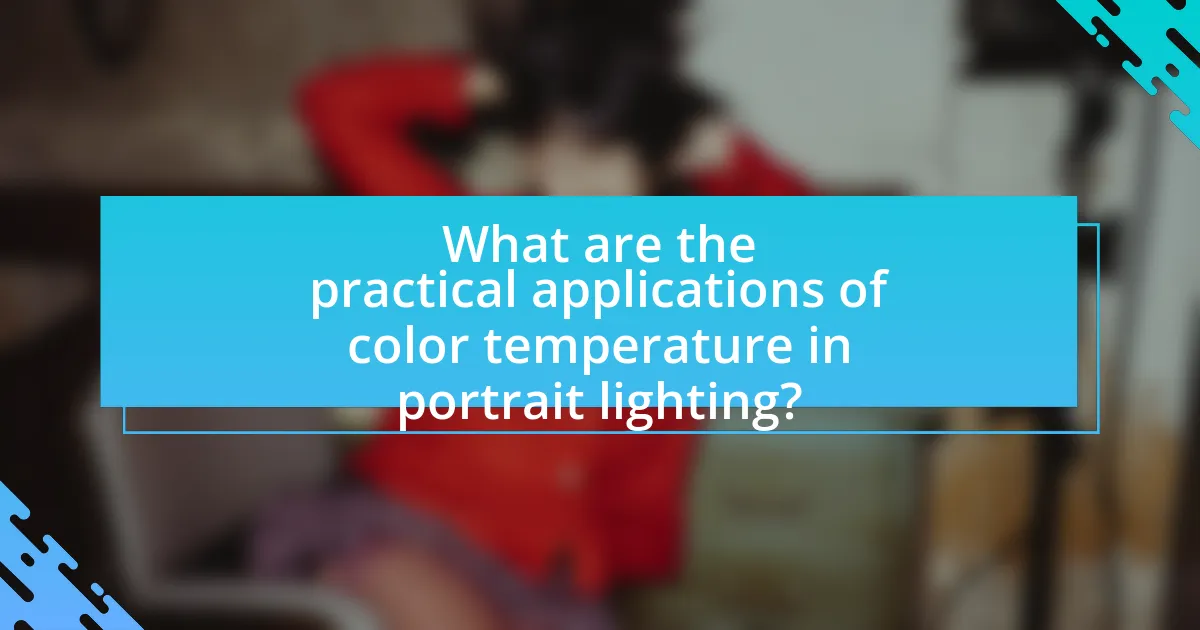
What are the practical applications of color temperature in portrait lighting?
Color temperature in portrait lighting is crucial for achieving the desired mood and aesthetic in photographs. It affects how skin tones are rendered, with warmer temperatures (around 3200K) creating a soft, inviting look, while cooler temperatures (around 5600K) produce a more neutral or clinical appearance. For instance, using a warmer light can enhance the warmth of skin tones, making subjects appear more vibrant and approachable, which is particularly effective in family portraits or lifestyle photography. Conversely, cooler light can be used to convey a sense of professionalism or detachment, often utilized in corporate headshots. Studies have shown that color temperature influences viewer perception; warmer tones are generally associated with comfort and intimacy, while cooler tones can evoke feelings of calmness or seriousness. Thus, understanding and manipulating color temperature allows photographers to tailor their lighting setups to match the emotional tone they wish to convey in their portraits.
How can photographers effectively use color temperature in their lighting setups?
Photographers can effectively use color temperature in their lighting setups by selecting light sources that match the desired mood and atmosphere of the portrait. For instance, using warmer light (around 2700K to 3500K) creates a cozy and inviting feel, while cooler light (above 5000K) can evoke a more clinical or dramatic effect. This strategic choice allows photographers to enhance skin tones and overall composition, ensuring that the lighting complements the subject’s features. Research indicates that color temperature significantly influences viewer perception and emotional response, making it a critical element in portrait photography.
What tools and equipment help control color temperature in portrait lighting?
Tools and equipment that help control color temperature in portrait lighting include gels, filters, and adjustable LED lights. Gels are colored transparent materials placed over light sources to modify their color temperature, allowing photographers to achieve warmer or cooler tones as needed. Filters, similar to gels, can be used on camera lenses or lights to adjust the color balance of the image. Adjustable LED lights offer the flexibility to change color temperature settings, enabling precise control over the lighting environment. These tools are essential for achieving the desired mood and aesthetic in portrait photography, as color temperature significantly influences the overall look of the image.
How can natural light be manipulated to achieve desired color temperatures?
Natural light can be manipulated to achieve desired color temperatures through the use of filters, reflectors, and diffusers. Filters, such as gels, can be placed over light sources to alter the color temperature, making the light warmer or cooler depending on the desired effect. Reflectors can bounce light in a way that enhances or modifies its color temperature, while diffusers soften the light and can also affect its warmth. For instance, using a warm-colored filter can shift daylight from a cooler 5500K to a warmer 3200K, which is often preferred in portrait lighting to create a more flattering skin tone.
What are common mistakes photographers make regarding color temperature?
Common mistakes photographers make regarding color temperature include failing to adjust white balance settings according to the lighting conditions, which can lead to unnatural skin tones. Many photographers also overlook the influence of ambient light on their subject, resulting in inconsistent color casts. Additionally, some photographers mistakenly rely solely on auto white balance, which may not accurately capture the intended mood or atmosphere of the scene. These errors can significantly affect the overall quality of portrait lighting, as accurate color temperature is crucial for achieving realistic and appealing images.
How can incorrect color temperature settings affect the final portrait outcome?
Incorrect color temperature settings can lead to unnatural skin tones and overall color casts in portrait photography. When the color temperature is set too low, portraits may appear overly warm, resulting in orange or yellow hues that distort the subject’s natural complexion. Conversely, if the color temperature is set too high, images can take on a blue or cool tint, making skin tones look sickly or unappealing. Research indicates that accurate color temperature settings are crucial for achieving true-to-life skin tones, as the human eye perceives color differently under varying lighting conditions. For instance, a study published in the Journal of Imaging Science and Technology highlights that maintaining a color temperature around 5000K to 5500K is optimal for natural skin representation in portraits.
What are the signs of poor color temperature choices in portrait photography?
Signs of poor color temperature choices in portrait photography include unnatural skin tones, where subjects appear overly orange or blue, indicating incorrect white balance settings. Additionally, harsh shadows and highlights can result from mismatched color temperatures, leading to an unflattering and inconsistent look. Furthermore, a lack of depth and dimension in the portrait can occur if the color temperature does not complement the lighting conditions, making the image appear flat. These issues arise because color temperature affects how light interacts with skin tones and other elements in the scene, emphasizing the importance of selecting the appropriate temperature for the desired mood and realism in portrait photography.
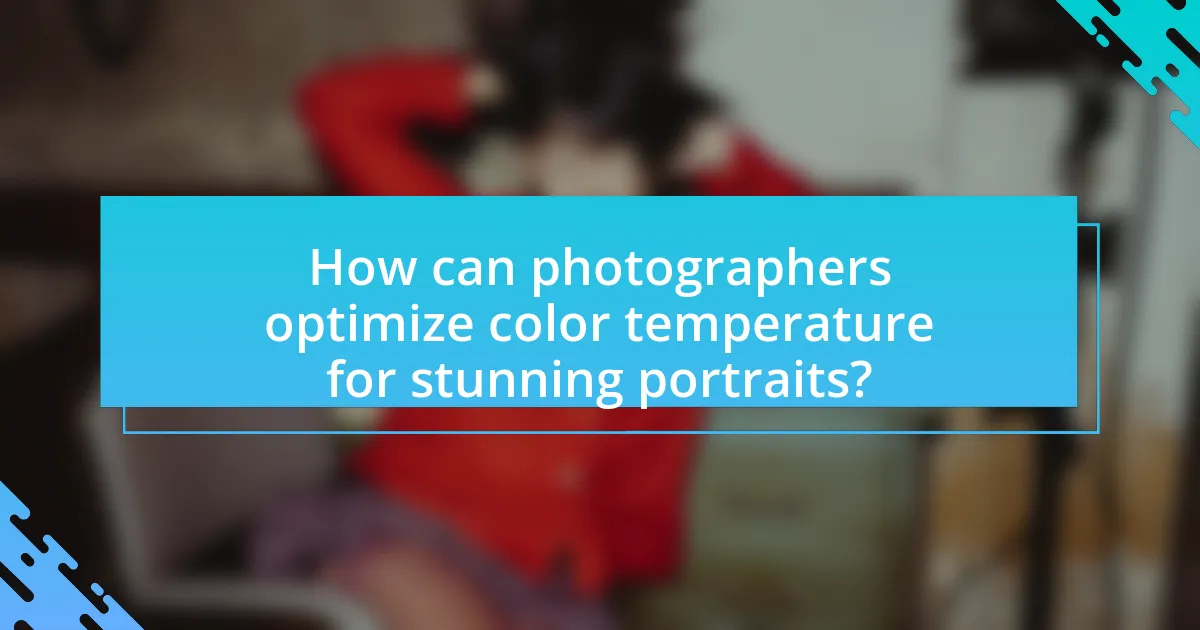
How can photographers optimize color temperature for stunning portraits?
Photographers can optimize color temperature for stunning portraits by adjusting their lighting sources to achieve the desired warmth or coolness in the image. Utilizing tools like white balance settings on cameras, or employing gels and filters on lights, allows photographers to manipulate the color temperature effectively. For instance, a color temperature around 5500K is ideal for natural daylight, while warmer temperatures (around 3200K) can create a cozy, inviting atmosphere. Studies show that the right color temperature enhances skin tones and overall image quality, making portraits more visually appealing.
What tips can improve the use of color temperature in portrait lighting?
To improve the use of color temperature in portrait lighting, photographers should utilize a color temperature meter to accurately measure and adjust the light source. This ensures that the lighting matches the desired mood and skin tones of the subject. Additionally, using gels or filters can help modify the color temperature of artificial lights to achieve a warmer or cooler effect, enhancing the overall aesthetic of the portrait. Studies show that proper color temperature alignment can significantly affect the perception of skin tones, making them appear more natural and appealing.
How can photographers balance color temperature with other lighting elements?
Photographers can balance color temperature with other lighting elements by using color gels, adjusting white balance settings, and employing mixed lighting techniques. Color gels can be placed over lights to match or contrast the color temperature of ambient light, allowing for a cohesive look in the final image. Adjusting the camera’s white balance settings helps to compensate for different light sources, ensuring accurate color representation. Additionally, mixed lighting techniques, such as combining daylight with artificial light, require careful consideration of the color temperatures involved to achieve a harmonious blend. These methods are supported by the understanding that color temperature affects mood and perception in photography, as evidenced by studies showing that different temperatures can evoke distinct emotional responses in viewers.
What are best practices for achieving consistent color temperature across multiple portraits?
To achieve consistent color temperature across multiple portraits, photographers should use the same light source and settings for all shots. This practice ensures that the color temperature remains uniform, as different light sources can emit varying color temperatures, leading to inconsistencies. For instance, using a daylight-balanced light source, such as a 5600K LED, across all portraits will maintain a consistent look. Additionally, utilizing a gray card for white balance calibration during the shoot helps to standardize color temperature in post-processing. Studies show that maintaining consistent lighting conditions can significantly enhance the overall coherence of a portrait series, making it visually appealing and professional.
What resources are available for learning more about color temperature in portrait lighting?
Books, online courses, and photography blogs are valuable resources for learning about color temperature in portrait lighting. Notable books include “Light Science and Magic” by Fil Hunter, which explains the principles of lighting, including color temperature, and “The Digital Photography Book” by Scott Kelby, which covers practical lighting techniques. Online platforms like Udemy and Coursera offer courses specifically focused on portrait lighting, often addressing color temperature. Additionally, photography blogs such as PetaPixel and Fstoppers frequently publish articles and tutorials that delve into the nuances of color temperature in portrait photography, providing practical examples and insights.
How can online courses and workshops enhance understanding of color temperature?
Online courses and workshops can enhance understanding of color temperature by providing structured learning experiences that include theoretical knowledge and practical applications. These educational formats often feature expert instructors who explain the science behind color temperature, including its measurement in Kelvin and its effects on mood and perception in portrait lighting. Additionally, interactive elements such as live demonstrations and hands-on assignments allow participants to experiment with different lighting setups, reinforcing their understanding through real-world application. Research indicates that active learning techniques, such as those used in workshops, significantly improve retention and comprehension of complex topics like color temperature.
What books or articles provide in-depth knowledge on color temperature in photography?
Books and articles that provide in-depth knowledge on color temperature in photography include “Understanding Exposure” by Bryan Peterson, which explains the relationship between light and color temperature, and “The Digital Photography Book” by Scott Kelby, which covers practical applications of color temperature in various lighting conditions. Additionally, the article “The Importance of Color Temperature in Photography” published on PetaPixel offers insights into how color temperature affects image quality and mood. These resources are widely recognized in the photography community for their comprehensive coverage of the subject.












